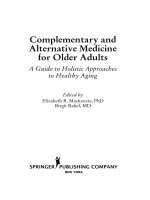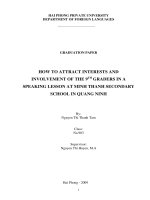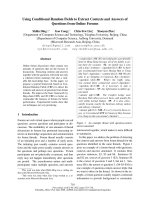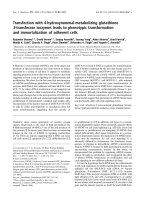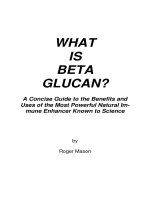A group music intervention using percussion instruments with familiar music to reduce anxiety and agitation of institutionalized older adults with dementia (2)
Bạn đang xem bản rút gọn của tài liệu. Xem và tải ngay bản đầy đủ của tài liệu tại đây (198.68 KB, 8 trang )
Seediscussions,stats,andauthorprofilesforthispublicationat: />
Agroupmusicinterventionusingpercussion
instrumentswithfamiliarmusictoreduce
anxietyadagitationof...
ArticleinInternationalJournalofGeriatricPsychiatry·June2012
DOI:10.1002/gps.2761·Source:PubMed
CITATIONS
READS
36
319
4authors,including:
Huei-ChuanSung
Tzai-LiLi
39PUBLICATIONS422CITATIONS
20PUBLICATIONS225CITATIONS
TzuChiUniversityofScienceandTechnology
SEEPROFILE
NationalTaiwanSportUniversity
SEEPROFILE
RogerWatson
UniversityofHull
553PUBLICATIONS5,617CITATIONS
SEEPROFILE
Someoftheauthorsofthispublicationarealsoworkingontheserelatedprojects:
Careerdevelopmenttipsfortoday’snursingacademic:bibliometrics,altmetricsandsocialmedia
Viewproject
AllcontentfollowingthispagewasuploadedbyHuei-ChuanSungon25December2016.
Theuserhasrequestedenhancementofthedownloadedfile.Allin-textreferencesunderlinedinblueareaddedtotheoriginaldocument
andarelinkedtopublicationsonResearchGate,lettingyouaccessandreadthemimmediately.
RESEARCH ARTICLE
A group music intervention using percussion instruments
with familiar music to reduce anxiety and agitation
of institutionalized older adults with dementia
Huei-chuan Sung1, Wen-li Lee2, Tzai-li Li3 and Roger Watson4
1
Department of Nursing, Tzu Chi College of Technology and Tzu Chi University, Hualien, Taiwan
Radiological Technology, Tzu Chi College of Technology, Hualien, Taiwan
3
Sport Promotion & Graduate Institute of Coaching Science, National Taiwan Sport University, Taoyuan County, Taiwan
4
School of Nursing and Midwifery, The University of Sheffield, Sheffield, UK
Correspondence to: H-C. Sung, RN, PhD, E-mail:
2
Name of the institution at which the research was conducted: Tzu Chi College of Technology and Tzu Chi University, Hualien, Taiwan
This experimental study aimed to evaluate the effects of a group music intervention on
anxiety and agitation of institutionalized older adults with dementia.
Methods: A total of 60 participants were randomly assigned to an experimental or a control group.
The experimental group received a 30-min music intervention using percussion instruments with
familiar music in a group setting in mid afternoon twice weekly for 6weeks, whereas the control
group received usual care with no music intervention. The Rating of Anxiety in Dementia scale
was used to assess anxiety, and Cohen-Mansfield Agitation Inventory was used to assess agitation
at baseline, week4 and week6.
Results: Repeated measures analysis of covariance indicated that older adults who received a group music
intervention had a significantly lower anxiety score than those in the control group while controlling for
pre-test score and cognitive level (F=8.98, p=0.004). However, the reduction of agitation between two
groups was not significantly different.
Conclusions: Anxiety and agitation are common in older adults with dementia and have been
reported by caregivers as challenging care problems. An innovative group music intervention using
percussion instruments with familiar music as a cost-effective approach has the potential to reduce
anxiety and improve psychological well-being of those with dementia. Copyright # 2011 John Wiley
& Sons, Ltd.
Objective:
Key words: dementia; music intervention; older adults; anxiety; agitated behaviours
History: Received 07 March 2011; Accepted 14 June 2011; Published online 8 August 2011 in Wiley Online Library
(wileyonlinelibrary.com).
DOI: 10.1002/gps.2761
Introduction
A rapid increasing prevalence of dementia is
reported worldwide, particularly in the developing
countries of Asia (Kalaria et al., 2008). Dementia is
a syndrome of cognitive deterioration, which may result in changes in personality and interfere with activities of daily living and social functions (Porth, 2004).
Copyright # 2011 John Wiley & Sons, Ltd.
Anxiety and agitated behaviours are commonly seen in
older adults with dementia and reported by caregivers
as challenging care problems. In Taiwan, 79.3% of
those with dementia display some types of behavioural
and psychological symptoms (Chow et al., 2002). The
stigmatization of mental illness in Taiwanese culture
may keep caregivers from reporting dementia and
behavioural problems (Fuh and Wang, 2008), unless
Int J Geriatr Psychiatry 2012; 27: 621–627.
H-C. Sung et al.
622
or until caregivers require assistance with behavioural
management (Kao and Stuifbergen, 1999). Consequently, anxiety and agitated behaviours of those with
dementia are often not properly assessed and managed, thereby creating a negative impact on those with
dementia and their caregivers. Untreated anxiety can
contribute to worsening of functional status (Ferretti
et al., 2001) and may trigger agitated behaviours in
those with dementia, which may further lead to institutionalization (Gibbons et al., 2002). Both anxiety
and agitated behaviours impose a burden on caregivers, health care institutions and financial resources
as the number of older adults diagnosed with dementia increases (Finkel, 2001).
Older adults manifesting anxiety and agitated
behaviours are often managed by antipsychotic
medications (Sink et al., 2005). However, given the
concerns of detrimental side effects caused by antipsychotic drugs, use of non-pharmacological care strategies have become vital in managing behavioural
symptoms for those with dementia (Ames et al.,
2005). As Complementary and Alternative Medicine
(CAM) has gained popularity worldwide in recent
years, CAM has been frequently used for older adults
with dementia and recommended to have potential
positive impact in treating certain types of dementia
and related symptoms (Diamond et al., 2003). Music
therapy or music intervention, as one approach to
CAM, has been studied and suggested as one of the
non-pharmacological interventions to manage behavioural and psychological symptoms of those with
dementia. Many studies have evaluated various types
of music activities on behavioural and psychological
problems for those with dementia, such as passive
music listening individually or in a group setting or
group music activities with singing or instrument
playing. Among the studies using music activities in
a group setting, there were some methodological limitations. One study used randomized controlled trial
design but did not mention the types of music used
(Raglio et al., 2008), one study evaluated the effect of
music therapy on those with dementia with inappropriate tools (Choi et al., 2009), and some had small
sample size (Svansdottir and Snaedal, 2006; Suzuki
et al., 2007; Choi et al., 2009). Furthermore, music
intervention has shown positive effects in reducing
anxiety in various populations, but limited studies
have examined the effect of group music intervention
on anxiety in those with dementia. This study aimed
to evaluate the effects of a group music intervention
using percussion instruments with familiar music on
anxiety and agitated behaviours of older adults with
dementia in a residential care facility.
Copyright # 2011 John Wiley & Sons, Ltd.
Methods
Participants
The participants were recruited from a residential care
facility in Taiwan. Inclusion criteria were as follows:
age of 65years or older diagnosed with dementia,
ability to engage in a simple activity and follow
simple directions, ability to understand Taiwanese or
Chinese, no severe hearing impairment, presence of
behavioural and psychological symptoms reported by
nursing staff and no obvious symptoms of acute pain
or infection. A sample size of 29 per group was needed
for repeated measures analysis for a large effect size,
power of 0.80, an alpha level of 0.05 (Cohen, 1992)
and an attrition rate of 10% reported in a previous
study about effect of group music for older people
with dementia (Sung et al., 2006a). A total of 60 participants who met the inclusion criteria were invited
and consented to participate in the study. Participants
were randomly assigned to either the experimental or
the control group using simple random sampling
method with a computer-generated list. In the experimental group, 27 participants completed the study
because of hospitalization of three participants. In
the control group, 28 completed the study because of
two relocations.
Group music intervention
The experimental group received music intervention
by active participation in a group for 30min in the
mid afternoon twice a week for 6weeks in the activity
room in the facility. The 30-min group music intervention consisted of a 5-min warm-up session of static
stretch of major muscle groups and breathing, a 20min session of active participation of the participants
using percussion instruments directed by the research
assistant in a group setting and a 5-min cool-down
session of stretching with soft music. A collection of
music and songs familiar to the participants was used
with the music session. The participants’ music preferences were assessed by asking the participants,
caregivers, families or nursing staff prior to the intervention, so the music selection used was based on
the majority of the participants’ preferred or familiar
music, which were Taiwanese and Chinese songs from
the 1950–1970s with pleasant moderate rhythm and
tempo. Participants were asked to follow the instruction of the research assistants trained in music intervention to move their extremities and play various
kinds of percussion instruments (such as hand bell,
Int J Geriatr Psychiatry 2012; 27: 621–627.
Group music intervention for older adults with dementia
tambourine, maracas, guiro tone block, flapper and
loop bell) with the familiar music. The participants
in the experimental group received a total of 12 sessions of group music intervention over 6weeks.
measurements. All participants were
assessed for agitated behaviours using CohenMansfield Agitation Inventory (CMAI) (CohenMansfield et al., 1989) and for level of anxiety using
the Rating of Anxiety in Dementia (RAID) scale
(Shankar et al., 1999) at baseline, week4 and week6.
The CMAI with good validity and reliability (Finkel
et al., 1992) was used to assess the occurrence of agitated behaviours in those with dementia. It consists
of 29 observable agitated behaviours rated on a
seven-point Likert scale according to frequency of
occurrence over 2weeks. Higher score represents
greater occurrence of agitated behaviours. The internal
consistency of the Chinese–Taiwanese CMAI was
established with a Cronbach’s alpha coefficient of
0.93 (Sung et al., 2006b).
The RAID scale was used to assess anxiety in
people with dementia according to their symptoms
of anxiety over the previous 2weeks. The RAID
has 18 items that are divided into the following
four subgroups: worry, apprehension and vigilance,
motor tension and autonomic hypersensitivity, and
each item is rated on a four-point scale. A score
of 11 or greater indicates significant clinical anxiety.
The RAID has demonstrated moderate to good reliability, with an interrater reliability that ranged
from 0.51 to 1 and test–retest reliability ranging
from 0.53 to 1 (Shankar et al., 1999). The internal
consistency of the Chinese–Taiwanese RAID was
0.73 (Sung et al., 2010).
Outcome
Procedure. Ethical approval was obtained from an
institution review board of a university in Taiwan.
Eligible participants and their family members or their
authorized representatives were informed and invited
to participate in the study. Not all participants were
able to give their informed consent because of cognitive impairment; therefore, informed consent was
obtained from their family members or authorized
representatives who were reassured of confidentiality
and anonymity.
The participants in the experimental group received
the 30-min group music intervention delivered by
trained research assistants in the afternoon twice a
week for 6weeks in the activity room, giving a total
of 12 sessions over 6weeks. The behaviours of the participants during each music session were assessed
by the observer assistants using modified CMAI.
Copyright # 2011 John Wiley & Sons, Ltd.
623
Meanwhile, participants in the control group only received usual care and did not attend the group music
interventions. The usual care matched the usual standard care that the participants in the experimental
group received, which included 24-h residential care
with activities of daily living, basic nursing care, meal
provision and some social activities (e.g. TV watching,
family visiting and parties for special events occasionally). All participants’ level of anxiety and occurrence
of agitated behaviours were assessed at baseline, week
4 and week6.
Data analysis. SPSS for Windows 17.0 (SPSS Inc.,
Chicago, IL, USA) was used for data analysis. Descriptive
statistics were generated for sample characteristics and
variables of interest. A repeated measures analysis of covariance was used to compare the differences in anxiety
scores and agitation scores between groups over time.
Results
The sample consisted of 55 participants with 27 in the
experimental group and 28 in the control group. The
average age was 81.37years (SD=9.14) for the experimental group and 79.5years (SD=8.76) for the control
group. Over half of the sample were female (65.8%),
widowed (70.2%), Taiwanese (72.5%) and Buddhist
(50.7%). The majority of the sample (76.2%) had
received no formal education. The mean score of cognitive function assessed by the Short Portable Mental
Status Questionnaire was 6.56 (SD=2.86) for the
experimental group and 4.43 (SD=3.17) for the control group, indicating both groups being classified as
having a mild to moderate level of cognitive impairment. There were no statistically significant differences
in the demographic characteristics between groups
except for cognitive function.
The mean anxiety score for the experimental
group was decreased from 10.04 (SD=10.48) at
baseline to 3.22 (SD=6.47) at week4, and slightly
increased to 3.89 (SD=4.02) at week6. The effect size
calculated for the pooled mean and pooled standard
deviation for the two groups was 0.90. The pairwise
comparison for the difference between the two groups,
using the estimated marginal means, gave a mean difference of 3.77 (SE 1.26) with 95% confidence interval
1.25–6.30. The mean anxiety score of the control
group was also reduced (Table 1). The mean agitation
score for both the experimental and control groups
was decreased from baseline to week6 overtime
(Table 1). Repeated measures analysis of covariance
indicated that older adults who received group music
Int J Geriatr Psychiatry 2012; 27: 621–627.
H-C. Sung et al.
624
Table 1 Mean and standard deviations of anxiety and agitation by
group and time (N=55)
Experimental (n=27)
M
Time points
anxiety
Baseline (T1)
Week4 (T2)
Week6 (T3)
Agitation
Baseline (T1)
Week4 (T2)
Week6 (T3)
Control (n=28)
SD
M
SD
10.04
3.22
3.89
10.48
6.47
4.02
12.14
9.39
5.36
10.73
9.49
4.34
36.26
33.59
32.7
13.28
8.45
4.98
35.79
33.54
31
6.61
8.45
2.96
SD, standard deviation.
intervention had a significantly lower anxiety score than
those in the control group over time while controlling
for pre-test score and cognitive level (F=8.98,
p=.004). However, the reduction of agitation between
two groups was not significantly different (F=.003,
p=0.95) (Table 2).
Discussion
Our study evaluated a complex intervention, which involved a 5-min warm-up session of static stretch of
Table 2 Repeated measures analysis of covariance for effect of group
music therapy on anxiety and agitation using pre-test score and cognitive function as covariates (N=55)
Variable
Source
SS
df
MS
F
p
1
51
340.85
37.96
8.98
0.004
1
1
10.61
101.80
0.29
2.82
0.59
0.1
51
36.14
1
51
0.18 0.003
55.39
0.95
Anxiety
Between subjects
Group
340.85
Within
1935.75
groups
(error)
Within subjects
10.61
Time
Group Â
101.80
time
Time Â
1843.25
within
group
(error)
Agitation Between subjects
Group
0.18
Within
2824.79
groups
(error)
Within subjects
Time
128.17
Group Â
34.47
time
Time Â
628.71
within
group
(error)
1
1
128.17 10.40 0.002
34.47 2.80 0.101
51
Copyright # 2011 John Wiley & Sons, Ltd.
12.33
major muscle groups and breathing, a 20-min group
music session using percussion instruments with familiar music and a 5-min cool-down session of
stretching with soft music, for older adults with dementia in a long-term care facility. This study was
conducted in accordance with Medical Research
Council guidance on evaluation of complex interventions (Anderson, 2008). Our study results indicate that
the group music intervention has a significant effect
on reducing anxiety scores in institutionalized older
adults with dementia. By participating in 12 sessions
of music intervention using percussion instruments
with familiar music in a group setting, the participants
had the motivation to engage in the activities and had
the opportunity to interact with other residents and
care staff. The participants in the experimental group
had greater reduction in anxiety scores after receiving
group music intervention than did those in the control
group. This result was consistent with those of studies
(Svansdottir and Snaedal, 2006; Tuet and Lam, 2006)
in which the level of anxiety in older adults with dementia was significantly decreased after receiving the
group music intervention. Comparison of our results
with previous research was difficult, as there were limited studies examining the effect of group music intervention on anxiety in those with dementia, and few
used a valid anxiety tool for those with dementia.
The minimal number of previous studies reporting
on anxiety in those with dementia may be because of
the lack of confidence on the tools for measuring anxiety in this population. The coexistence of anxiety and
other psychological and behavioural problems in those
with dementia can make the assessment more complicated. Current scales for anxiety in dementia vary in
their construction of symptoms and can overlap with
depression scales (Gibbons et al., 2006). The RAID
score used in this study is the current available scale,
which was specifically developed for assessing anxiety
in older adults with dementia with good validity and
reliability.
In our study, group music intervention significantly
decreased the agitation scores in older adults who received group music intervention, but the reduction
did not reach significant difference compared with
those of the control group over time. This result was
similar to that of a study by Winckel et al. (2004) in
which no significant improvement was found on
behavioural problems of patients with moderate to severe dementia after 6weeks of music-based group
exercises. However, several studies did find positive
impact of group music intervention on agitated behaviours in those with dementia (Jennings and Vance,
2002; Brotons and Marti, 2003; Svansdottir and
Int J Geriatr Psychiatry 2012; 27: 621–627.
Group music intervention for older adults with dementia
Snaedal, 2006; Sung et al., 2006a; Suzuki et al., 2007;
Raglio et al., 2008; Choi et al., 2009). In our study,
the group music intervention reduced the occurrence
of agitated behaviours in those who received the
6-week group music intervention over time, but the
reduction was not significantly different compared
with those who did not receive group music. This
may be due to the low occurrence of agitated
behaviours in both groups at baseline, so the improvement of the group music intervention on agitated
behaviours was limited.
Theories have been proposed and seek to understand behavioural problems and what interventions
produce positive outcomes for those with dementia.
Lawton’s person–environment fit theory (1982) postulated that individuals with lower competence (for
instance, older adults with cognitive impairment) are
sensitive to the demands of their environment. If
environmental demands are too strong for the level
of competence, maladaptive behaviour will occur.
Lawton’s theory suggests that supporting the remaining abilities and modifying the environment can facilitate person–environment fit for older adults with
dementia. The Progressively Lowered Stress Threshold
model (PLST) (Hall and Buckwalter, 1987) is another
model which also suggests environment modification
for managing behavioural problems of those with
dementia. According to the PLST model, older adults
with cognitive impairment caused by dementia have
a lowered stress threshold related to impaired person–
environment interaction and therefore are less able to
manage stress and process external stimuli. The inability
to process external stimuli may cause a progressive
decline in their stress threshold level and a heightened
potential for anxiety and agitated behaviours. This
model suggests that caregivers can facilitate more adaptive behaviours by manipulating external stimuli and
modifying activities to prevent or reduce anxiety and
agitation in those with dementia. On the basis of the
PLST model, Gerdner (1997) further proposed a
mid-range theory of individualized music intervention
for agitation to explain the effects of individualized
music on agitated behaviours in people with dementia.
The individualized music intervention for agitation
theory hypothesized that presentation of carefully
selected music, matched with personal preferences,
provides an opportunity for those with dementia to
connect with the past, and the familiarity of music
from the past will in turn assist them in recalling
memories based on intact remote memory and
memory of music in those with dementia. Music can
also change the focus of attention and provide an
interpretable stimulus, over-riding stimuli in the
Copyright # 2011 John Wiley & Sons, Ltd.
625
environment that are meaningless or confusing to
the person with dementia. Music that elicits positive
memories from an earlier period in the person’s life
will have a soothing effect on people with dementia,
which would prevent or alleviate anxiety or agitation
(Gerdner, 1997; Gerdner, 2000).
Therefore, introducing a sense of familiarity into a
new environment or maximizing familiarity in an
existing environment by using familiar music may be
a viable strategy to stimulate memories associated with
positive feelings in those with dementia. Music, which
can elicit memories and positive feelings in those with
dementia, has the potential to decrease anxiety and the
occurrence of agitated behaviours. In our study, we
used the participants’ familiar music as background
music, such as Chinese and Taiwanese songs from
the 1950–1970s with pleasant moderate rhythm and
tempo, which might elicit positive memories and feelings of the participants with dementia. Our study
found that group music intervention using familiar
music significantly reduced the participants’ anxiety.
This was supported by the results of a study in which
familiar music or songs were used in the group music
intervention and significantly reduced anxiety of older
adults with dementia (Svansdottir and Snaedal, 2006).
Our study found that participants had more purposeful responses along with the familiar music during the
group music sessions. In addition, participation in
group music intervention also provided the older
adults with dementia a channel for communication
and social interaction. The participants responded to
the music by smiling, hand clapping and singing
along. It is likely that popular music from early adult
years can elicit the memory of those with dementia
and facilitate their emotional and physical responses
during the group music sessions. Therefore, music familiarity and preference of those with dementia need
to be considered and assessed in planning group music
intervention.
Anxiety and agitation were both reduced progressively for the control group at post-tests. This may
be due to the reduction of anxiety and agitation of
those in the experimental group affecting those in
the control group after the participants in the experimental group finished the group music sessions and
went back to their residential area, staying with those
from the control group. Participants in the experimental group were less anxious and agitated after each
group music session and therefore were less likely to
provoke the emotion of other residents including participants in the control group living in the same residential area. Therefore, it is possible that the
participants in the control group may become less
Int J Geriatr Psychiatry 2012; 27: 621–627.
H-C. Sung et al.
626
anxious and agitated with less interference by other
residents. Future research can consider allocating participants from the same residential area as the experimental or control group and using a crossover design
to avoid this problem.
Agitation in older adults with dementia has been
researched extensively, whereas anxiety in those with
dementia has received much less attention. The
coexistence of anxiety and other psychological and
behavioural problems in those with dementia is commonly reported and can result in increased complexity
of assessment and diagnosis of anxiety (Gibbons et al.,
2006). Nevertheless, agitation and anxiety are troublesome behavioural problems and can have a negative
impact on the physical and psychosocial functions of
those with dementia and also increase the burden on
the caregivers. Group music intervention therefore
can be an accessible and cost-effective care intervention for managing anxiety and agitated behaviours of
those with dementia in residential care facilities.
The generalization of the study result is limited because the sample was drawn from one residential care
facility. Blinding of the participants and data collectors
was not possible, and this is identified as a potential
source of bias. There is also a lack of a comprehensive
tool for measuring anxiety and agitation symptoms
with good validity and reliability; therefore, additional
development and refinement of tools are needed. This
study was conducted as rigorously as possible and controlled for as many variables as possible. However,
some extraneous variables such as the impact of contact by nursing staff and visitors, use of medication
and the influence of weather conditions during the
implementation of group music sessions need to be
taken into account as these factors might affect the
outcomes measured. Longer follow-up after the conclusion of the music interventions will be needed for
future study to understand the residual effects of the
music intervention.
dementia care. Group music intervention using percussion instruments with familiar music can be an effective and cost-effective approach to reduce anxiety
and agitated behaviours of those with dementia and
to alleviate the burden of nursing caregivers in residential care facilities. Group music intervention is easy
for care staff to learn to implement for those with dementia in residential care facilities. Administrators and
nursing staff in residential care facilities can consider
incorporating group music intervention into daily activity programme for those with dementia. An innovative group music intervention has the potential to
improve the psychological well-being of those with dementia in residential care facilities.
Contribution of authors
Conception and design: H.C.S., W.L.L., R.W.; data
analysis and interpretation: H.C.S., T.L.L., R.W.;
manuscript preparation: H.C.S., W.L.L., T.L.L., R.W.
Conflict of interest
None declared.
Key points
•
•
•
Six-week group music intervention using percussion instruments with familiar music leads to
reduction in anxiety of older adults with dementia.
An innovative group music intervention can be a
cost-effective approach to reduce anxiety and
improve psychological well-being of those with
dementia.
Nursing home administrators and nursing staff
can consider incorporating group music intervention into daily activity programme for those
with dementia.
Conclusion
Effective care approaches for managing anxiety and
agitated behaviours of older adults with dementia are
essential, particularly given the increasing prevalence
of dementia and the associated anxiety, as well as the
negative consequences of these behavioural problems
on older adults themselves and others, which all lead
to increased burden and costs in care. Therefore, reduction and prevention of anxiety and agitated behaviours of those with dementia is one of the most
important goals of therapeutic interventions in
Copyright # 2011 John Wiley & Sons, Ltd.
Acknowledgement
This work was supported by Taiwan National Science
Council [NSC 96-2314-B-277-003-MY2].
References
Ames D, Ballard C, Cream J, et al. 2005. For debate: should novel antipsychotics ever
be used to treat the behavioural and psychological symptoms of dementia (BPSD)?
Int Psychogeriatr 17: 3–29.
Int J Geriatr Psychiatry 2012; 27: 621–627.
Group music intervention for older adults with dementia
Anderson R. 2008. New MRC guidance on evaluating complex interventions. BMJ
337: a1937.
Brotons M, Marti P. 2003. Music therapy with Alzheimer’s patients and their family
caregivers: a pilot project. J Music Ther 40: 138–150.
Choi AN, Lee MS, Cheong KJ, et al. 2009. Effects of group music intervention on behavioral and psychological symptoms in patients with dementia: a pilot-controlled
trial. Int J Neurosci 119: 471–481.
Chow TW, Liu CK, Fuh JL, et al. 2002. Neuropsychiatric symptoms of Alzheimer’s
disease differ in Chinese and American patients. Int J Geriatr Psychiatry 17: 22–28.
Cohen J. 1992. A power primer. Psychol Bull 112: 155–159.
Cohen-Mansfield J, Marx M, Rosenthal AS. 1989. A description of agitation in a nursing home. J Gerontol 44: 77–84.
Diamond BJ, Johnson SK, Torsney K, et al. 2003. Complementary and alternative
medicines in the treatment of dementia: an evidence-based review. Drugs Aging
20: 981–998.
Ferretti L, McCurry SM, Logsdon R, et al. 2001. Anxiety and Alzheimer’s disease.
J Geriatr Psychiatry Neurol 14: 52–58.
Finkel SI. 2001. Behavioral and psychological symptoms of dementia: a current focus
of clinicians, researchers, and caregivers. J Clin Psychiatry 62: 3–6.
Finkel SI, Lyons JS, Anderson RL. 1992. Reliability and validity of the CohenMansfield Agitation Inventory in institutionalized elderly. Int J Geriatr Psychiatry
7: 487–490.
Fuh JL, Wang SJ. 2008. Dementia in Taiwan: past, present, and future. Acta Neurol
Taiwan 17: 153–161.
Gerdner LA. 1997. An individualized music intervention for agitation. J Am Psychiatr
Nurses Assoc 3: 177–184.
Gerdner LA. 2000. Effects of individualized versus classical “relaxation” music on the
frequency of agitation in elderly persons with Alzheimer’s disease and related disorders. Int Psychogeriatr 12: 49–65.
Gibbons LE, Teri L, Logsdon R, et al. 2002. Anxiety symptoms as predictors of
nursing home placement in patients with Alzheimer’s disease. J Clin Geropsychol
8: 335–342.
Gibbons LE, Teri L, Logsdon RG, et al. 2006. Assessment of anxiety in dementia: an
investigation into the association of different methods of measurement. J Geriatr
Psychiatry Neurol 19: 202–209.
Hall GR, Buckwalter KC. 1987. Progressively lowered stress threshold: a conceptual
model for care of adults with Alzheimer’s disease. Arch Psychiatr Nurs 1: 399–406.
Copyright # 2011 John Wiley & Sons, Ltd.
View publication stats
627
Jennings B, Vance D. 2002. The short-term effects of music therapy on different types
of agitation in adults with Alzheimer’s. Act Adapt Aging 26: 27–33.
Kalaria RN, Maestre G.E, Arizaga R, et al. 2008. Alzheimer’s disease and vascular dementia in developing countries: prevalence, management, and risk factors. Lancet
Neurol 7: 812–826.
Kao HF, Stuifbergen AK. 1999. Family experiences related to the decision to institutionalize an elderly member in Taiwan: an exploratory study. Soc Sci Med 49:
1115–1123.
Lawton MP. 1982. Competence, environmental press, and the adaptation of older
adults. In Aging and the Environment: Theoretical Approaches, Lawton MP,
Windley PG, Byerts TO (eds.). Springer: New York; 33–59.
Porth CM. 2004. Essential of Pathophysiology: Concepts of Altered Health States.
Lippincott Williams & Wilkins: Philadelphia, PA.
Raglio A, Bellelli G, Traficante D, et al. 2008. Efficacy of music therapy in the treatment of behavioral and psychiatric symptoms of dementia. Alzheimer Dis Assoc
Disord 22: 158–162.
Shankar KK, Walker M, Frost D, et al. 1999. The development of a valid and reliable
scale for rating anxiety in dementia (RAID). Aging Ment Health 3: 39–49.
Sink KM, Holden KF, Yaffe K. 2005. Parmacological treatment of neuropsychiatric
symptoms of dementia: a review of the evidence. JAMA 293: 596–608.
Suzuki M, Kanamori M, Nagasawa S, et al. 2007. Music therapy-induced changes in
behavioral evaluations, and saliva chromogranin A and immunoglobulin A concentrations in elderly patients with senile dementia. Geriatr Gerontol Int 7: 61–71.
Sung H, Chang S, Lee W et al. 2006a. The effects of group music with movement intervention on agitated behaviours of institutionalized elders with dementia in
Taiwan. Complement Ther Med 14: 113–119.
Sung H, Chang AM, Abbey J. 2006b. The effects of preferred music on agitation of
older people with dementia in Taiwan. Int J Geriatr Psychiatry 21: 999–1000.
Sung H, Chang AM, Lee WL. 2010. A preferred music listening intervention to
reduce anxiety in older adults with dementia in nursing homes. J Clin Nurs 19:
1056–1064.
Svansdottir HB, Snaedal J. 2006. Music therapy in moderate and severe dementia of
Alzheimer’s type: a case-control study. Int Psychogeriatr 18: 613–621.
Tuet RWK, Lam LCW. 2006. A preliminary study of the effects of music therapy on
agitation in Chinese patients with dementia. Hong Kong J Psychiatry 16: 87–91.
Winckel AV, Feys H, Weerdt WD. 2004. Cognitive and behavioural effects of musicbased exercises in patients with dementia. Clin Rehabil 18: 253–260.
Int J Geriatr Psychiatry 2012; 27: 621–627.
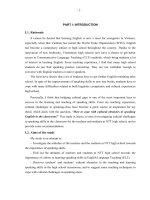

![Tài liệu Báo cáo khoa học: Specific targeting of a DNA-alkylating reagent to mitochondria Synthesis and characterization of [4-((11aS)-7-methoxy-1,2,3,11a-tetrahydro-5H-pyrrolo[2,1-c][1,4]benzodiazepin-5-on-8-oxy)butyl]-triphenylphosphonium iodide doc](https://media.store123doc.com/images/document/14/br/vp/medium_vpv1392870032.jpg)


